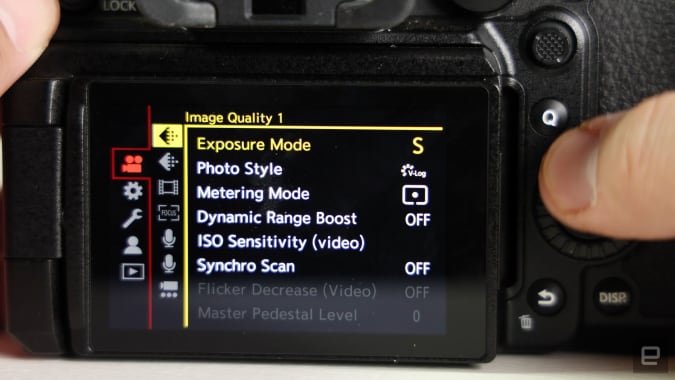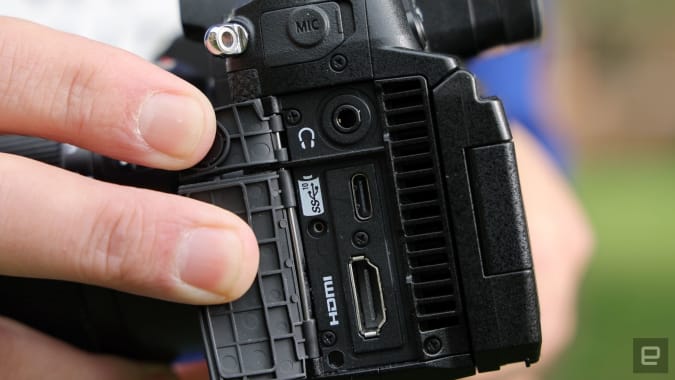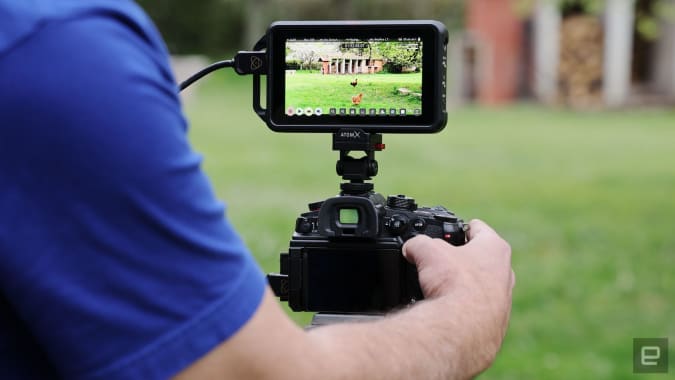Panasonic launched the GH5 over five years ago, helping set off a mini vlogging boom and confirming the potential of mirrorless cameras for video. Its replacement has finally come in the form of the $2,200 GH6 with an all-new sensor and desirable features like ProRes, 5.7K 60p video and an all-new stabilization system.
Panasonic had the video creator market largely to itself in 2018, but things are different now. It’s crowded with models from Canon, Sony and Nikon, all offering similar features to the GH6 for a similar price. Some of those, like Sony’s A7 IV and the Canon EOS R6have full-frame sensors and superior phase-detect autofocus systems.
pros
- Pro level video quality
- Outstanding in-body stabilization
- Great handling
- Affordable
cons
- Sub par autofocus
- Relatively heavy
- Battery life isn’t amazing
Panasonic has its own full-frame lineup too, so it’s effectively competing with its own Lumix S5 model. Is there still a place for a video-centric Micro Four Thirds camera with contrast-detect autofocus? I took a final production version of the GH6 out in the French countryside to find out.
Body and handling
Gallery: Panasonic GH6 review gallery | 32 photos
Gallery: Panasonic GH6 review gallery | 32 photos
Apart from the similar control layout, the GH6 doesn’t look much like the GH5 anymore. The first substantial change is the hump on the back. It accommodates both a multi-angle articulating display and an active cooling system with a fan and vents for continuous video shooting at high video resolutions.
It’s got a new grip too, which is perhaps the largest I’ve ever seen on any camera, mirrorless or otherwise. It uses a tackier rubber material and has a bigger ridge for your fingers, giving a secure grasp on the camera at all times.
All the buttons and dials are in roughly the same spots, save a few exceptions. The most noticeable change is the addition of a switch on the top left corner that lets you lock out any controls you want. The other is a dedicated autofocus button for changing AF areas, models, eye detection and more.
Another big change is the addition of a second video record button on the front, ideally placed for vloggers. There’s also a nice dedicated audio control button that lets you quickly access levels, quality and more without diving into menus. Finally, there’s a second button up front that can be set to do whatever you want.
Steve Dent/Engadget
The GH6 uses the new style of Panasonic menu found on the GH5 II and S5. It’s among the easiest to use of any mirrorless camera, with logical categories and not too much scrolling needed. Plus, it can be operated by touch or using the buttons and dials.
As mentioned, the GH6 has a fully articulating 1.84-million dot rear touchscreen, as you’d expect, but it borrowed a feature from the full frame S1H as well: It tilts up by about 45 degrees, letting you keep it clear of the microphone and HDMI ports for vlogging or external capture.
The 3.68 million dot OLED electronic viewfinder is as sharp as rivals, but the refresh rate is limited to 60Hz. Since the GH6 is primarily designed for video that’s not too big a deal, as higher EVF frequencies mostly help action photographers.
With the introduction of ProRes and ProRes HQ, internal data rates can hit up to 1.9Gbps (237.5 MB/s). To that end, the GH6 now has a high-speed CFexpress slot, along with a UHS II slot. The drawback of having one very fast card and one very slow card is that you can’t backup ProRes (or 800Mbps All-I H.264 video) to the SD card. That could be a problem for videographers that absolutely require a backup when shooting video for weddings and other live events.
Steve Dent/Engadget
As for ports, it has a full-sized HDMI port as you’d hope on such a camera, along with a USB-C port that supports power delivery so you can charge or power the camera while shooting. Of course, it has headphone and microphone jacks, and you can upgrade that to four-channel XLR inputs using Panasonic’s $400 DMW-XLR1 hotshoe adapter.
Overall, the GH6 is a well designed and great-handling camera, particularly for video. Key settings like audio levels, video resolution and autofocus are easy to change and monitor.
There are a few drawbacks, though. It’s heavy for a Micro Four Thirds camera at 823g, and the battery life isn’t great either. It’s rated for just 350 still images on a charge, compared to 400 on the GH5 with the same settings, and about an hour of continuous 4K shooting. On one of our shoots, however, it didn’t manage more than about 45 minutes of stop-start shooting, so you’ll want to buy and carry a lot of extra cells.
Video
Just like the GH5, the GH6 is a video creator’s camera above all. For that, it’s better than its predecessor in nearly every way, from resolution to stabilization to dynamic range.
The GH6 can shoot 5.7K all the way up to 60 fps, DCI 4K up to 120 fps and 1080p at 240 fps. As with other Panasonic cameras, it supports anamorphic shooting up to 5.7K. That lets you use lenses from VazenSirui and others and get those dramatic JJ Abrams horizontal lens flares. 10-bit video with billions of colors is available for most of these formats, with an Intraframe I mode for easier editing and LongGop L mode, (both with H.264 and H.265 codecs), to conserve space.
Steve Dent/Engadget
It also supports 12-bit ProRes and ProRes HQ, formats that gobble card space but are easier to edit than MP4. You can only shoot 5.7K 25p ProRes video for now, but ProRes DCI 4K and full HD are coming later via a firmware update. RAW output at up to C4K (4,096 x 2,160) 120p to an external Atomos Ninja V+ recorder will also be introduced down the road.
The 5.7K ProRes footage allows for crisp downsampled 4K footage or cropping where needed, while delivering the best possible quality with minimal compression and 12 bits of color. It’ll also play in real time on a decent editing computer, but you’ll need lots of storage space – the file sizes are massive.
Meanwhile, 4K at 120 fps is a big plus for dramatic slow-mo. Unlike with rivals, there’s no cropping or dropping in sharpness at those higher frame rates, and 10-bit video is available. The only downside to 120p is that a feature called Dynamic Range Boost isn’t supported.
So what is that? Rather than Dual Native ISO like the GH5, the GH6 has Dynamic Range Boost. It combines high and low-gain readouts to deliver extra dynamic range at ISO settings over 800. With the feature turned off, dynamic range is a bit below the GH5 and when enabled, it’s a full stop higher.
The GH6 is also Panasonic’s first non-professional camera with full V-Log, not hobbled V-Log L. With all that, video quality is outstanding, particularly in demanding, contrasty scenes. It’s sharp, colors are right on point and the extra stop of dynamic range over the GH5 gives editors more room to dial down bright scenes and amp up shadows in post-production.



